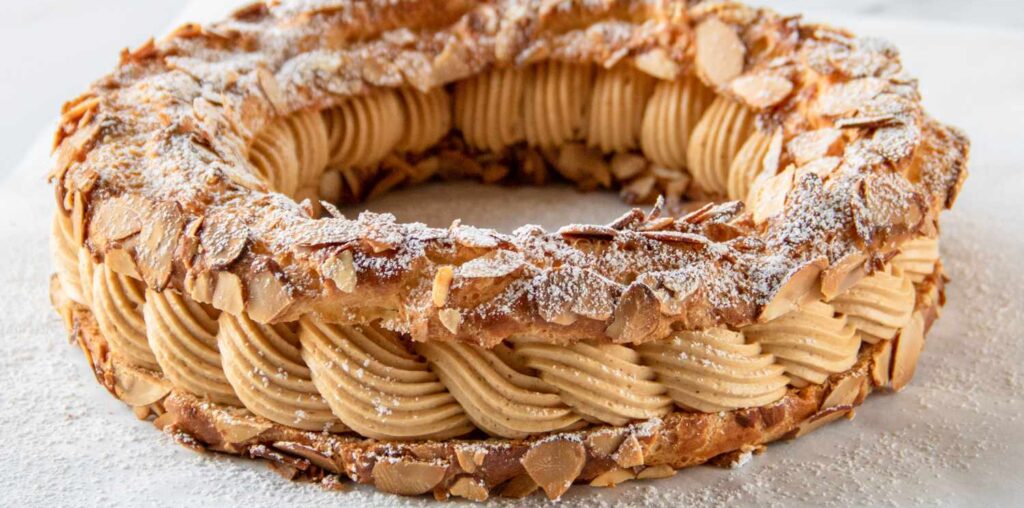Why It Works
- Caramelizing the nuts and sugar together infuses the praline with a nutty caramel flavor, while the addition of baking soda makes it easier to grind into a paste and deepens its overall flavor.
- The combination of milk and water in the dough browns the choux ring and ensures a crisp shell.
- Egg wash helps the almonds adhere to the surface of the choux ring.
- Using pastry cream and butter at the correct temperature will produce a soft, fluffy crème mousseline.
The Paris–Brest is a classic French pastry, featuring a crisp, almond-studded baked ring of pâte à choux that’s split in half horizontally, liberally filled with praline crème mousseline—a heady mixture of vanilla pastry cream, nutty praline paste, and whipped butter—and finished with a dusting of powdered sugar.
Serious Eats / Debbie Wee
This bakery staple was created in 1910 by pastry chef Louis Durand, as an homage to the long-distance Paris-Brest-Paris bicycle race (the pastry’s circular shape is meant to evoke that of a bicycle wheel). Pâtisserie Durand, which is still owned and operated by the Durand family, claims to have the original recipe, but fortunately this hasn’t prevented pastry chefs around the world from putting forth their own spins on the dessert.
Our recipe keeps things classic. The praline paste starts as a scaled-down batch of Stella’s hazelnut brittle—a mix of water, sugar, corn syrup, hazelnuts, almonds, and salt cooked to a tawny brown and cooled on a greased baking sheet. Adding baking soda partway through the process alkalizes the candy, both deepening its flavor and making it easier to grind into a nut butter–like paste in a food processor.
For the choux ring, we follow our foolproof technique. A 50/50 mix of milk and water for the liquid component of the dough yields a crisp and well-browned shell when baked, while adding a touch of sugar to the choux base lends it subtle sweetness that complements the creamy hazelnut filling.
Piping the choux ring requires a steady hand and a bit of patience. It consists of piping three individual rings—two concentric circles touching each other, and a third piped on top to overlap them. When baked, the three choux rings fuse together to form the pastry’s characteristic bicycle-tire shape (it’s crucial that the rings are all touching, otherwise you’ll end up with distinct rings). If piping isn’t your strong suit, don’t fret; if you make a mistake, you can always start over by scraping any piped batter back into the pastry bag. We lightly brush the ring with egg wash and sprinkle it with sliced almonds before transferring it to the oven to bake.
Now it’s time to whip up the crème mousseline. Crème mousseline often goes by another name: German buttercream, or, as Stella calls it, “whipped vanilla custard frosting.” We begin by beating softened butter with the paddle attachment in a stand mixer until it’s creamy and smooth, and then incorporate the prepared praline paste, beating in a few tablespoons of the pastry cream at a time until smooth. The final step is aerating the crème mousseline. To accomplish this, switch to the whisk attachment and whip until the mixture is light and fluffy.
Serious Eats / Debbie Wee
Assembling the Paris–Brest may seem like the most intimidating part, as photo-worthy renditions require a skilled piping hand. But don’t let inexperience stop you, since there’s no wrong way to do it as long as the filling sits tall inside the bottom half. With practice (or maybe a bit of luck), it’ll be a showstopper, but no matter how professional the filling looks, we promise it’ll be no less delicious.

